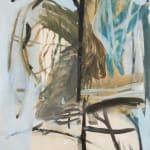Peter Lanyon 1918-1964
Pine Shore, 1960
watercolour, gouache and ink on paper
76 x 54.5 cm
29 7/8 x 21 1/2 in
29 7/8 x 21 1/2 in
signed and dated;
also signed, titled and dated verso
also signed, titled and dated verso
Peter Lanyon’s Pine Shore (1960) evokes the sensation of moving through the rugged Cornish landscape—wind cutting across cliffs, sea spray rising, and the shifting light of the coast. The painting...
Peter Lanyon’s Pine Shore (1960) evokes the sensation of moving through the rugged Cornish landscape—wind cutting across cliffs, sea spray rising, and the shifting light of the coast. The painting captures not a static view but an experience of place, built from sweeping gestures of blue, earthy browns, and black linear forms. Lanyon’s abstraction is rooted in lived encounter, his brushwork translating the physical act of walking, gliding, or soaring across the land into pictorial rhythm.
Exhibited at his important 1960 show at Gimpel Fils, Pine Shore belongs to a period when Lanyon was extending his language of abstraction into one of profound physicality and movement. Unlike many of his contemporaries, he did not abandon landscape but reimagined it, collapsing figure and ground, air and earth, into dynamic painterly fields. His paintings of this moment placed him at the forefront of post-war British art, bridging the St Ives tradition with the wider international debates of Abstract Expressionism.
Lanyon’s significance lies partly in his ability to connect English landscape painting with the energy of American abstraction. His work was admired in the United States, where exhibitions in the early 1960s won critical attention and a dedicated and enduring following. He offered a distinctively British counterpart to the likes of Pollock and de Kooning, grounded in place yet equally expansive in ambition. This cross-Atlantic recognition helped secure his reputation as one of Britain’s most innovative voices of the era.
Exhibited at his important 1960 show at Gimpel Fils, Pine Shore belongs to a period when Lanyon was extending his language of abstraction into one of profound physicality and movement. Unlike many of his contemporaries, he did not abandon landscape but reimagined it, collapsing figure and ground, air and earth, into dynamic painterly fields. His paintings of this moment placed him at the forefront of post-war British art, bridging the St Ives tradition with the wider international debates of Abstract Expressionism.
Lanyon’s significance lies partly in his ability to connect English landscape painting with the energy of American abstraction. His work was admired in the United States, where exhibitions in the early 1960s won critical attention and a dedicated and enduring following. He offered a distinctively British counterpart to the likes of Pollock and de Kooning, grounded in place yet equally expansive in ambition. This cross-Atlantic recognition helped secure his reputation as one of Britain’s most innovative voices of the era.
Provenance
Gimpel Fils, London, where acquired by the Hon. Michael Astor (1916-1980), October 1960 and thence by descent to the previous ownerExhibitions
London, Gimpel Fils, Recent Paintings by Peter Lanyon, 11 October - 5 November 1960, no. 28Join Our Mailing List
We won't spam you. We will send a monthly email highlighting new artworks and events, with very occasional other mailings.
* denotes required fields
In order to respond to your enquiry, we will process the personal data you have supplied in accordance with our privacy policy. You can unsubscribe or change your preferences at any time by clicking the link in any emails.



